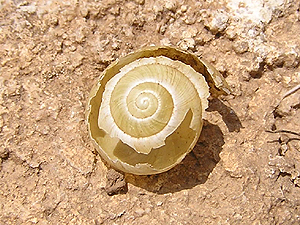
A white-lipped snail's shell, opened by a carabid's mandibles
following the shell whorls. Picture: [RN]
Animals that eat snails can be found in almost every systematic group. Snails usually are quite defenceless and so are welcome sources of protein to many animals. Even those that usually do not eat snails will do so in times of meagre food supply. That is also true for man: It seems hard to imagine, that, while today snails are an expensive delicacy for few, during the Thirty Years' War farmers ate snails, because they had nothing else to eat.
Most terrestrial snails could reach several years of age, Roman snails even older than twenty. Only a small part, though, survives until maturity. The eggs of terrestrial snails already are a welcome food to many small animals, including other snails. Should the young snails survive until hatching, the danger for life and limb is not over – as soon as the young snails begin to crawl around, they become a potential prey for all sorts of insects living on the ground. That is why the climb plant stems as soon as possible, though also here life is anything but safe.
 A white-lipped snail's shell, opened by a carabid's mandibles following the shell whorls. Picture: [RN] |
|
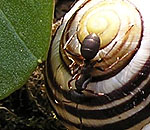 Looking at invertebrate animals first, it becomes obvious that carnivorous
insect almost always also eat snails. Large snails, such as the Roman snail, can
defend themselves against ants and other small insects by producing foamy mucus
that stops the ants from reaching the snail. But ants usually come in numbers,
so they are able to overpower the snail anyway, even at the expense of the one
or other worker ant.
Looking at invertebrate animals first, it becomes obvious that carnivorous
insect almost always also eat snails. Large snails, such as the Roman snail, can
defend themselves against ants and other small insects by producing foamy mucus
that stops the ants from reaching the snail. But ants usually come in numbers,
so they are able to overpower the snail anyway, even at the expense of the one
or other worker ant.
Against larger insects, this mucus defence does not help. Especially carnivorous beetles, such as ground beetles (Carabidae) and fireflies (Lampyridae) (among the latter especially the larvae) are used to attacking and eating snails.
Where ground beetles hunt for snails, often a larger number of empty snail shells can be found, opened by ground beetles' mandibles. Snails may well survive a ground beetle attack, if they manage to retreat in time, even if their shells are damaged in the process.
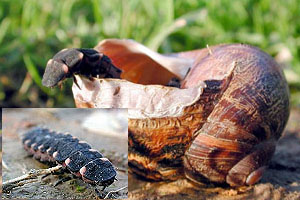 Picture: François Panchout. Source: Le monde des insectes. |
The picture on the right shows a firefly larva (Lampyris noctiluca) that has killed a brown garden snail (Cornu aspersum) and is about finished eating it. Of course, it is much easier to kill a banded snail (Cepaea), whose bands and colours will not help it against an insect.
![]() Insectes et
"escargots" : Insectes malacophages et hélicophiles.
Insectes et
"escargots" : Insectes malacophages et hélicophiles.
Marsh flies (Sciomyzidae) are associated with snails and mussels, which they parasite or prey upon. While most species live in the water and attack pond snails (Lymnaeidae) and pea mussels (Pisidium), there are also numerous terrestrial species, living predominantly in forest habitats and feeding on terrestrial snails (Cochlicopa, Aegopinella und Discus).
![]() Hubert
Pschorn-Walcher & Werner Heitland: Parasitoide Online:
Familie Sciomycidae, Hornfliegen. (In German)
Hubert
Pschorn-Walcher & Werner Heitland: Parasitoide Online:
Familie Sciomycidae, Hornfliegen. (In German)
![]() Bugguide.net: Marsh
flies or Snail killing flies (Sciomyzidae).
Bugguide.net: Marsh
flies or Snail killing flies (Sciomyzidae).
Not only insects eat snails, also many arachnids: Among the harvestmen (Opiliones) there are species (Ischyropsalis hellwigi) that almost exclusively live on snails.
 Fire salamander (Salamandra salamandra), a female. [RN] Note the snail below the salamander's head! |
Besides arthropods there are also many carnivorous snail species. Those not only eat other snails, but also for example earth worms.
Species mainly living on earthworms are daudebardiids and testacellids. Among those living on other snails, there are the Dalmatian predator (Poiretia cornea) and the rosy wolf snail (Euglandina rosea), the latter originally from Florida in the United States.
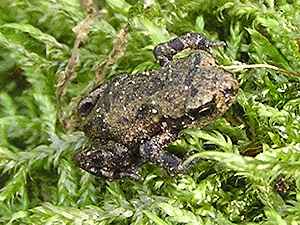 Common toad (Bufo bufo), a juvenile shortly after metamor- phosis. [RN] |
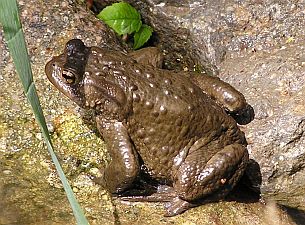 Adult common toad (Bufo bufo). [RN] |
There are snail eaters in all vertebrate classes. Among the amphibians mainly larger frogs, but especially toads eat snails, such as the common toad (Bufo bufo). That is why the latter should be a very welcome guest in every garden: It does not even hesitate to eat the large slugs, whose slime makes them inedible to other animals. Also the fire salamander (Salamandra salamandra) and its black relative, the alpine salamander (Salamandra atra) eat small slugs and snails. The fire salamander even lurks for its prey on mushrooms the gastropods visit to eat.
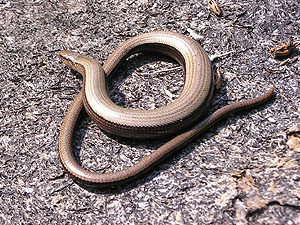 Blindworm (Anguis fragilis). [RN] |
Among reptiles, mainly small non venomous species also eat snails, for example the European blindworm (Anguis fragilis) and the Australian snail skink (Tiliqua gerrardii), a small lizard. Among snakes there are for example certain canopy snakes from Costa Rica.
Songbirds usually also eat snails, if their size allows them to do so. The song thrush (Turdus merula) has solved the problem how to crush a snail's shell by throwing them on a suitable hard stone. Usually it uses the same stone ever and ever again, which is why there many broken snail shells can be found. Such a stone is then called a thrush anvil. On the other hand, snails have adapted to this by a most uncommon form of camouflage – depending on vegetation cover and ground colour, banded snails can be yellow or red, banded or unbanded, always those camouflaged best are selected to survive. Next to song birds, also fowl and ducks (for example the so-called runner ducks) eat snails. Stork, heron and other birds also will not leave a tasty snail aside.
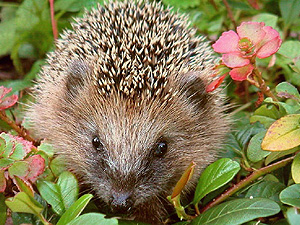 European hedgehog (Erinaceus europaeus). Picture: Torsten Freitag. |
Among mammals, especially insectivores also will eat snails, but also some carnivores will fatten their menu with a snail. Especially fond of snails and also slugs are hedgehogs (Erinaceus europaeus), moles (Talpa europaea) and shrews. The hedgehog has a special method to rid slugs of their sticky slime: It rolls them in earth and then cleans them with its paws.
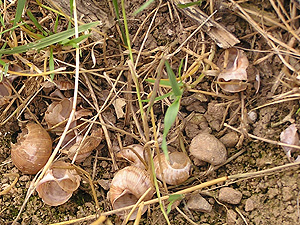 On a snail farm, shrews have bitten open the shells of these Roman snails (Helix pomatia). [RN] |
Of course, one enemy of snails remains to be named at last: Man. Not only are there many snail species that are picked and eaten since Stone Age times. There is also the increasing destruction of nature that has its effects on snails as well. Snails usually remain in one place (see the page about door snails (Clausiliidae)). That is why changes in their environment – destruction and pollution – affect them more than other animals. Only one of many examples is the extinction of endemic tree snails on the Pacific islands of French Polynesia, such as Moorea. Besides being an example for human stupidity and narrowness of mind, it very well shows what happens to small scale ecosystems, if foreign snail species are introduced.
It must, however, remain understood that very similar things happen in front of our door. For example the Durham or Lusitanian slug (Arion vulgaris), introduced from the Iberian Peninsula, slowly but continually replaces the domestic slug species, such as red and black slug (Arion rufus and ater).
The Lusitanian slug is by far the worse garden pest: It reproduces faster and so does more damage. Looking at the red lists it becomes obvious, that there are also very many snail species threatened by extinction. As well as their relatives, the mussels, fresh water snails, such as the bladder snail (Aplexa hypnorum) or the fresh water limpet (Ancylus fluviatilis) are affected by pollution and destruction.
These days, every school child knows threatened birds, such as the stork and it knows, those animals slowly die out in our countries because of waters polluted and environment destroyed – rivers straightened and dug out.
But it should not be forgotten, that many snail and mussel species are among those animals. The red list in the German state of Baden-Württemberg alone mentions 235 species of snails (204) and mussels (31) threatened by extinction, disproportionately many of those fresh water species.